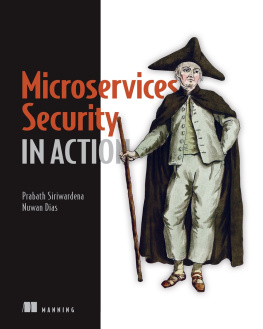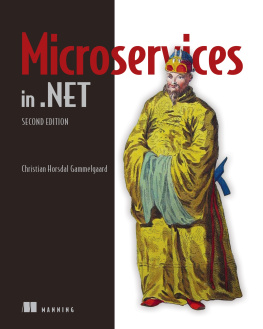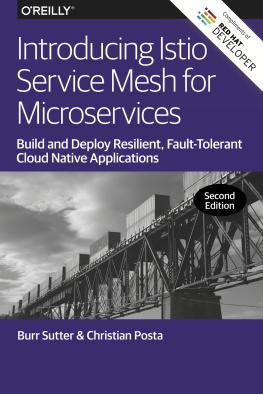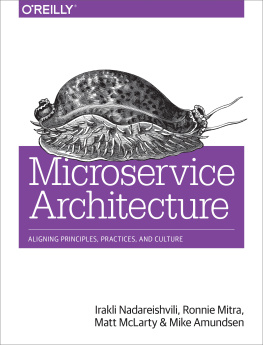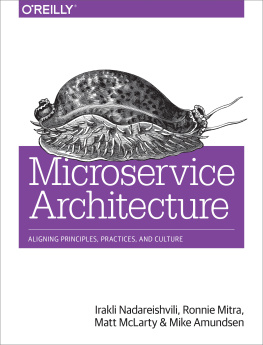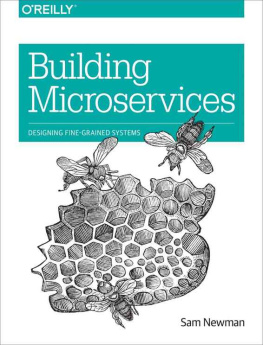
Microservices Security in Action
Prabath Siriwardena and Nuwan Dias
To comment go to liveBook

Manning
Shelter Island
For more information on this and other Manning titles go to
manning.com
Copyright
For online information and ordering of these and other Manning books, please visit manning.com. The publisher offers discounts on these books when ordered in quantity.
For more information, please contact
Special Sales Department
Manning Publications Co.
20 Baldwin Road
PO Box 761
Shelter Island, NY 11964
Email: orders@manning.com
2020 by Manning Publications Co. All rights reserved.
No part of this publication may be reproduced, stored in a retrieval system, or transmitted, in any form or by means electronic, mechanical, photocopying, or otherwise, without prior written permission of the publisher.
Many of the designations used by manufacturers and sellers to distinguish their products are claimed as trademarks. Where those designations appear in the book, and Manning Publications was aware of a trademark claim, the designations have been printed in initial caps or all caps.
Recognizing the importance of preserving what has been written, it is Mannings policy to have the books we publish printed on acid-free paper, and we exert our best efforts to that end. Recognizing also our responsibility to conserve the resources of our planet, Manning books are printed on paper that is at least 15 percent recycled and processed without the use of elemental chlorine.

| Manning Publications Co. 20 Baldwin Road Technical PO Box 761 Shelter Island, NY 11964 |
Development editor: | Marina Michaels |
Technical development editor: | Jonathan Thoms and Joshua White |
Review editor: | Ivan Martinovi |
Production editor: | Deirdre S. Hiam |
Copy editor: | Sharon Wilkey |
Proofreader: | Keri Hales |
Technical proofreader: | Thorsten P. Weber |
Typesetter and cover designer: | Marija Tudor |
ISBN: 9781617295959
dedication
To Dr. Sanjiva Weerawarana, our mentor for more than a decade and for many more years to come!
front matter
preface
While working at WSO2 for more than a decade, weve seen how the integration domain evolved over time from SOAP-based services to JSON/RESTful services and then to microservices. We spent most of our early days at WSO2 contributing to the Apache Axis2 project, which was a popular SOAP engine in those days, and to the Apache Rampart project, which implements many Organization for the Advancement of Structured Information Standards (OASIS) standards for web services security. Even though SOAP was quite promising in those days, it started to fade rapidly over time, and clearly JSON/RESTful services had won. Most of the microservice implementations we see today follow RESTful design principles.
In the last two to three years, weve seen a genuine interest from many companies weve worked with to move into microservices architecture, and projects starting from scratch are adopting microservices principles. Most of the early adopters of microservices just wanted to get things done, and worried mostly about implementing functional requirements. They didnt worry too much about security, although they should have. In many cases, securing microservices would mean securing the interactions among microservices with Transport Layer Security (TLS), and may be, for some, enforcing mutual TLS for service-to-service authentication. But none of them are quite adequate. There are two main reasons many didnt worry much about security: complexity and awareness.
Some time back, we found that most tools for securing microservices were not easy to use or couldnt address the challenges specific to microservices deployments. This complexity was a barrier to securing microservices. At the same time, people who didnt put much effort into security werent fully aware of the risks. We started hearing these stories from many of our customers as well as from the extended open source community we work with. That motivated us to write this book on securing microservices. Bringing an idea from inception to reality takes considerable time and effort. We lived with this idea of writing a book for more than two years until Manning reached out to us. During that period, with the increased adoption of microservices, the infrastructure around microservices security also evolved.
Writing a book about a rapidly evolving domain is bit of a challenge; you never know when your book will be obsolete. After discussing this challenge with the publisher, we decided to put more weight on principles and patterns, and use tools just to demonstrate how to apply those principles and patterns in practice. This was our ground rule in picking up the technology stack for the book. We use Spring Boot / Java to develop all the samples, though we dont expect you to know either Java or Spring Boot in detail. If you have development experience in any programming language, you should be able to follow all the samples in the book with no difficulty.
Security itself is a larger domain. Securing microservices can mean different things to different people, based on their experiences and expectations. This fact was highlighted by one of the reviewers of the book, who comes from a security testing background. In our book, we wanted to focus on managing access to microservices. In other words, we wanted to focus on securing access to microservices with authentication and authorization. So, the book doesnt talk about protecting microservices against different types of attacks, such as SQL injection, cross-site scripting (XSS), cross-site request forgery, and so on.
After a marathon effort that spanned slightly more than two years, we are glad to see that our book on microservices security is out. We are also excited that this is the very first book on securing microservices. We hope you will enjoy reading it!
acknowledgments
This book would not have been possible without the support of many amazing people:
- Brian Sawyer, senior acquisitions editor at Manning, reached out to us and helped us structure our book proposal.
- Marina Michaels, development editor at Manning, was very patient and tolerant of us throughout the publishing process and provided invaluable advice during the writing process.
- To the rest of the staff at Manning: Deirdre Hiam, the project editor; Sharon Wilkey, the copyeditor; Keri Hales, the proofreader; and Ivan Martinovic ,the review editor.
- All the Manning Early Access Program (MEAP) subscribers of the book.
- Thorsten P. Weber, technical proofreader, who helped us review the code to make sure all the code samples work as expected.
- Tim Hinrichs, one of the creators of the Open Policy Agent (OPA) project, and Andrew Jessup, one of the creators of the SPIFFE project, who helped us by reviewing the appendices on OPA and SPIFFE.
- Sanjiva Weerawarana, the founder and CEO of WSO2, and Paul Fremantle, the CTO of WSO2, who have constantly mentored us for many years.
Next page
